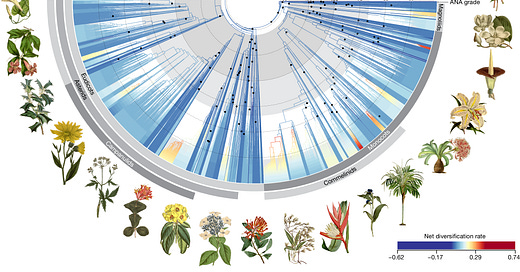A New Tree of Life for Flowering Plants
A new study using DNA from living plants and historic herbarium specimens offers a fresh look at how thousands of plants are related.

Last week, an exciting new botanical study by an impressive 279 co-authors from 138 institutions was published in the journal Nature. The research took eight years to complete and offers access to the DNA sequences of more than 9,500 flowering plants! These DNA sequences enabled scientists to take a deeper look at modern plants, as well as answer questions about their evolutionary history.
Zuntini, A.R., Carruthers, T., Maurin, O. et al. Phylogenomics and the rise of the angiosperms. Nature (2024). https://doi.org/10.1038/s41586-024-07324-0
The research article is available through open access (free to the public!) and I definitely encourage you to check it out. Here, I offer a summary of some key takeaways from this work.
What are angiosperms?
Angiosperms are flowering plants, representing nearly 90% of all plant life on Earth. They are incredibly important not only to most land-based ecosystems, but also to humans as sources of food, medicine, and in support of livelihoods. The challenge? Until now, we knew very little about their evolutionary history.
DNA sequencing can unlock the secrets of plants
The team used advanced, high-throughput DNA sequencing to examine the evolutionary history of 9,506 species from 7,923 genera and create a tree of life that illustrates how different plants are related to one another, and how those relationships emerged over time.
Herbaria were critical to this endeavor!
As noted in the article:
Sampling for this project was possible thanks to the collaborative effort of many biodiversity institutions from around the world, including 163 herbaria in 48 countries. More than one-third of species were sourced directly from herbarium specimens, some dating back nearly 200 years.
Incredible! I make note of the critical importance of maintaining herbarium specimen collections in nearly every scientific talk I give. After all, what scientist from the 1800s could have ever imagined that the plants they collected in their lifetime would someday be the key to solving an evolutionary mystery using technologies that didn’t exist until centuries later? Indeed, what might we be able to learn from such specimens another two hundred years from now?
In case you missed it, check out my article in the Washington Post or my Foodie Pharmacology podcast episode on the importance of herbaria and why we must do all we can to save them at a time. This is especially critical at a time when universities are actively divesting of these treasures.
How might this inform climate research?
One mystery that scientists have long grappled with in researching the fossil record is when an early period of diversification (explosion of flowering plant diversity) occurred and why. This study corroborates bursts of diversity occurring in the Early Cretaceous period (100-145 million years ago in the era of megafauna … dinosaurs!). They also found evidence in support of another burst in diversification of flowering plants in the Cenozoic Era (66 million years ago to now, when mammals, birds, and flowering plants dominated the landscape). Through understanding the evolution of flowering plants and taking in to consideration the Earth’s climatic conditions, we can better investigate how our current changing climate might shape the evolution of current species into the future.
The Takeaway
There is so much to love about this study, from the collaborative nature of the research, to the integration of historic resources (herbaria) with cutting-edge DNA technologies, to the answers and additional questions it reveals about the history and future of plants on Earth.
Yours in health, Dr. Quave
Cassandra L. Quave, Ph.D. is a scientist, author, speaker, podcast host, wife, mother, explorer, and professor at Emory University School of Medicine. She teaches college courses and leads a group of research scientists studying medicinal plants to find new life-saving drugs from nature. She hosts the Foodie Pharmacology podcast and writes the Nature’s Pharmacy newsletter to share the science behind natural medicines. To support her effort, consider a paid or founding subscription, with founding members receiving an autographed 1st edition hardcover copy of her book, The Plant Hunter.
Available in hardcover, paperback, audio, and e-book formats!







Will check out the details soon. Amazing to sequence that many species, considering the once formidable human genome project that aimed to sequence the entire genome of just one species, granted much more complex.
I wonder how closely the new genetic sequencing information tracks with the phenotype -based phylogeny we learned in Bio 101?